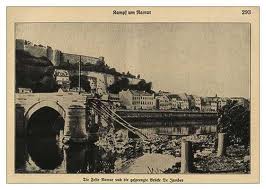 Thanks to the generous offer of my fellow scribbler, Cleve Moffet, who recently invited me to dip into his extraordinary collection of Belgian memorabilia, I have just finished reading a gem of a little period piece: Six Weeks at the War, by Millicent Duchess of Sutherland (The Times, London, 1914). Chapter Two of my emerging magnum opus takes place in Namur in 1914, during its siege and fall. I had done quite a bit of research before writing, of course, but the Millicent Duchess of Sutherland was actually there, as a Red Cross volunteer, and her book is an an eye witness account of that extraordinary, though now forgotten, period early in the war when Belgium’s great fortified cities – Liège, Namur, Antwerp – were bombarded and cracked open like nuts by the massive German siege guns. It was as I had described it – the blown-up bridges, the shells thundering into the city like express trains, the fires, the destruction, the panic, the exodus – but I couldn’t help but become interested in the author herself. Previously a well-known London society hostess, she seemed to have come into her own through her Red Cross work, standing up to ‘the invader’, working behind enemy lines, nursing hideously injured men of all nationalities, demonstrating great courage and fortitude, and always standing by her ‘ambulance’ of nurses and surgeons. The most arresting memory I take from the book, though, is a photograph of two German soldiers guarding Namur’s utterly shattered market place. One of the two soldiers looks to be fifteen at the most, and the other could have been only slightly older. Behind them is a local boy of about five. He is dressed in a skirted smock and … smoking a pipe.
Thanks to the generous offer of my fellow scribbler, Cleve Moffet, who recently invited me to dip into his extraordinary collection of Belgian memorabilia, I have just finished reading a gem of a little period piece: Six Weeks at the War, by Millicent Duchess of Sutherland (The Times, London, 1914). Chapter Two of my emerging magnum opus takes place in Namur in 1914, during its siege and fall. I had done quite a bit of research before writing, of course, but the Millicent Duchess of Sutherland was actually there, as a Red Cross volunteer, and her book is an an eye witness account of that extraordinary, though now forgotten, period early in the war when Belgium’s great fortified cities – Liège, Namur, Antwerp – were bombarded and cracked open like nuts by the massive German siege guns. It was as I had described it – the blown-up bridges, the shells thundering into the city like express trains, the fires, the destruction, the panic, the exodus – but I couldn’t help but become interested in the author herself. Previously a well-known London society hostess, she seemed to have come into her own through her Red Cross work, standing up to ‘the invader’, working behind enemy lines, nursing hideously injured men of all nationalities, demonstrating great courage and fortitude, and always standing by her ‘ambulance’ of nurses and surgeons. The most arresting memory I take from the book, though, is a photograph of two German soldiers guarding Namur’s utterly shattered market place. One of the two soldiers looks to be fifteen at the most, and the other could have been only slightly older. Behind them is a local boy of about five. He is dressed in a skirted smock and … smoking a pipe.
Leave a Reply